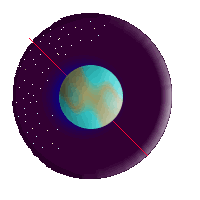
Framework of Time, Cosmic Geography
| Pre-Dawn Star Gazing |
| Framework of Time |
| Heaven on Earth |
| Planets, the wanderers |
| Catastrophe! Precession |
| It's Written in the Stars |
| About this Site |
| Resources |
| Feedback Form |
| Index |

|
| As the World Turns ... |
|---|
|
The twinkling stars sit in a fixed pattern. They all move
slowly together across the sky. They rise slightly later
each night, making a full cycle over the course of a year.
People named the brightest stars. They associated images with clusters of stars, a lion here, a bull there, and named them also. They observed the patterns of planetary motion. When they told stories about important events that happened, others could figure out when these things had happened by decoding references to planetary locations and combinations. The cycle of jupiter/saturn conjunctions is especially useful for this. People who know the stars pattern can tell the time by them. The time of night and the time of year. Typically the ones which rise just before the sun, are used as seasonal markers. This is called 'rising heliacally'. In the northern temperate zone, some of the stars surrounding the "north pole" never rise or set, like other stars do, they are always up there. The other stars revolve around these. To our ancestors it was obvious that the world (not necessarily the ground) turned on an axis, they saw it every night. This pivot point of the world was noted and remarked upon. It was variously described as a tree or as the axis of a grinding mill. If you are far enough north, some of the southern stars are never seen. People knew about them from travelers and from stories of previous world ages. Near the poles, the stars motion through the sky is very arched and circular. Near the equator, the stars appear to move more directly up, over, and down. People in the tropics figured out how to use the stars position and movements for navigation. The Polynesians used them to reliably cross thousands of miles of open ocean on their trips to Hawaii. They acurately passed this information through many generations, by encoding the details in songs. There is a particular band of the sky in which the sun, moon, and other wanderers (planets) travel. This was of course noticed. The constellations in this area, are those we know of as the zodiac. The reason astrology discusses the location of the various planets in these 'signs' and not the rest of the sky, is simply that these are the only places the planets go. Another remarkable feature of the night sky is the Milky Way, a large swath of white light cutting across the sky. It is often referred to as a river. In the myths of various peoples, it was the path taken by the souls of the dead enroute to heaven. |
